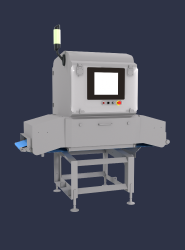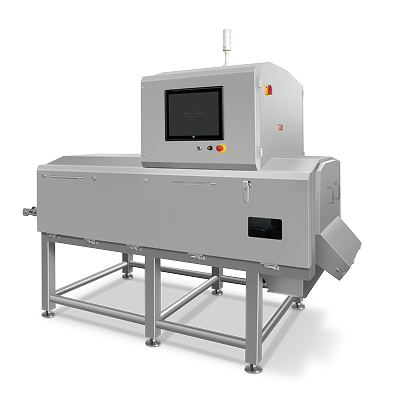RaymanTech Dual Energy Residual Bone Detector: Absolute Bone Removal in Poultry Processing
Bone fragments are the poultry industry’s most persistent and expensive headache. Even the most advanced mechanical deboning systems leave behind collar bones, rib tips, fan bones, cartilage shards, and calcified tendon ends. These remnants are rarely metallic, often flexible, and almost impossible to see with the naked eye once the fillet is marinated, breaded, or frozen. Yet consumers notice them immediately—and one viral complaint can cost millions in lost contracts and brand damage.
The RaymanTech Dual Energy Residual Bone detector was designed for one mission: make “boneless” mean exactly that.
The technology exploits a fundamental physical difference: calcium in bone absorbs low-energy X-rays far more strongly than the surrounding soft tissue. By firing high- and low-energy beams at the same instant and computing the ratio image, the system isolates bone with startling clarity—even when the fragment is only partially calcified, lying flat against the meat, or hidden beneath a layer of batter. Detection limits routinely reach 2.0–2.5 mm for hard bone and 4–5 mm for cartilage, regardless of product temperature, moisture injection level, or coating thickness.
The dedicated Residual Bone models (RXD-MS-C series) are optimized exclusively for poultry geometry and speed. Single-lane versions handle 240 mm belts; double-lane units manage 400 mm at up to 40 m/min—perfectly synchronized with modern high-speed portioners, coaters, and freezers. An integrated global poultry bone database—continuously updated with new images from North America, South America, Europe, and Asia—ensures the AI recognizes every possible bone type from broilers, layers, turkeys, and ducks.
Engineered for the Brutal Reality of Poultry Plants
Hygiene demands in poultry are among the harshest in food processing. The Residual Bone detector is built to survive them:
·Full IP69K construction throughout (including generators)
· 80 °C / 100 bar washdown certified
· Continuously welded 316 stainless frame with no hollow sections
· Tool-free belt removal and open sanitary design
· Complete machine cleanable in under five minutes
Radiation safety is class-leading at <1 µSv/h—operators can stand beside the machine all day with zero exposure concern. An industrial air-conditioning module keeps the generator stable even when the plant is running foam cleaning cycles at 45 °C.
Beyond Detection: Operational Intelligence
The software goes far beyond simple bone flagging. It classifies fragments by type (hard bone vs. cartilage), size, and location within the fillet. This data feeds upstream process control—rising collar-bone counts might signal cone-blade wear, while increased cartilage could indicate over-mature birds. Managers receive live dashboards showing bone rates by shift, supplier, or flock, turning the inspection machine into a powerful quality-management tool.
Additional capabilities include:
· Weight estimation and portion-size verification
· Overlap compensation for pumped or formed products
·Automatic learning of new marinade or breading recipes
· Full reject traceability with stored images of every bone event
· Integration with deboning-line robotics for closed-loop correction
Because the hardware platform is identical to the rest of the Dual Energy family, plants that later add fat analysis or general low-density detection simply activate software—no new conveyor or floor space needed.
Where It Fits in Modern Poultry Lines
The Residual Bone detector is typically installed immediately after deboning and before marination, coating, or freezing. Common positions:
· Post-cone deboning on breast lines
·After thigh/wing separation
· Pre-nugget forming or grinding
· Final check before tray packing or IQF
When absolute bone removal is non-negotiable—whether for retail “boneless” claims, export certificates, or simply protecting consumer trust—this machine has become the industry’s definitive answer.
See the technology that has redefined what “boneless” really means: https://www.raymantech.us/x-ray-for-chicken-bone-product/


Related Articles
-
 Nov-19-2025
Nov-19-2025RaymanTech Standard Dual Energy X-ray: Seeing the Invisible in Overlapped and Uneven Products
Picture a high-speed frozen broccoli line running at 60 meters per minute. Thousands of dark-green florets tumble straight from the IQF tunnel onto the belt. They overlap, fold, twist, and pile two or three deep. Some are still lightly coated with ice, others are perfectly dry. Hidden somewhere in that moving green avalanche is a sliver of blue plastic film, a tiny piece of rubber gasket, or a fragment of thinlearn more -
 Nov-19-2025
Nov-19-2025RaymanTech Dual Energy Residual Bone Detector: Absolute Bone Removal in Poultry Processing
Bone fragments are the poultry industry’s most persistent and expensive headache. Even the most advanced mechanical deboning systems leave behind collar bones, rib tips, fan bones, cartilage shards, and calcified tendon ends. These remnants are rarely metallic, often flexible, and almost impossible to see with the naked eye once the fillet is marinated, breaded, or frozen. Yet consumers notice them immediately—and one viral complaint can cost millions in lost contracts and brand damage.learn more -
 Nov-19-2025
Nov-19-2025Revolutionizing Needle Detection in the Meat Industry: Overcoming Hidden Risks with AI-Powered X-Ray Technology
As global demand for premium, safe meat products surges, processors are turning to advanced technologies to safeguard their supply chains. At RaymanTech, our AI-enhanced X-ray inspection systems are at the forefront of this transformation, offering unparalleled precision in detecting metal foreign objects like needle fragments. This article delves into the persistent pain points of needle detection in pork, beef, and lamb processing, the limitations of conventional tools, and how our innovative solutions deliver superior performance, drawing on the latest industry insights from RaymanTech's meat sector expertise.learn more

Quick Links
Contact
Tel: 717-490-1513
Add: 1050 Kreider Drive -
Suite 500, Middletown,
PA 17057







